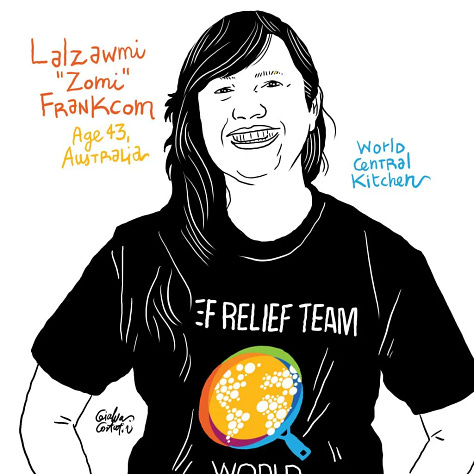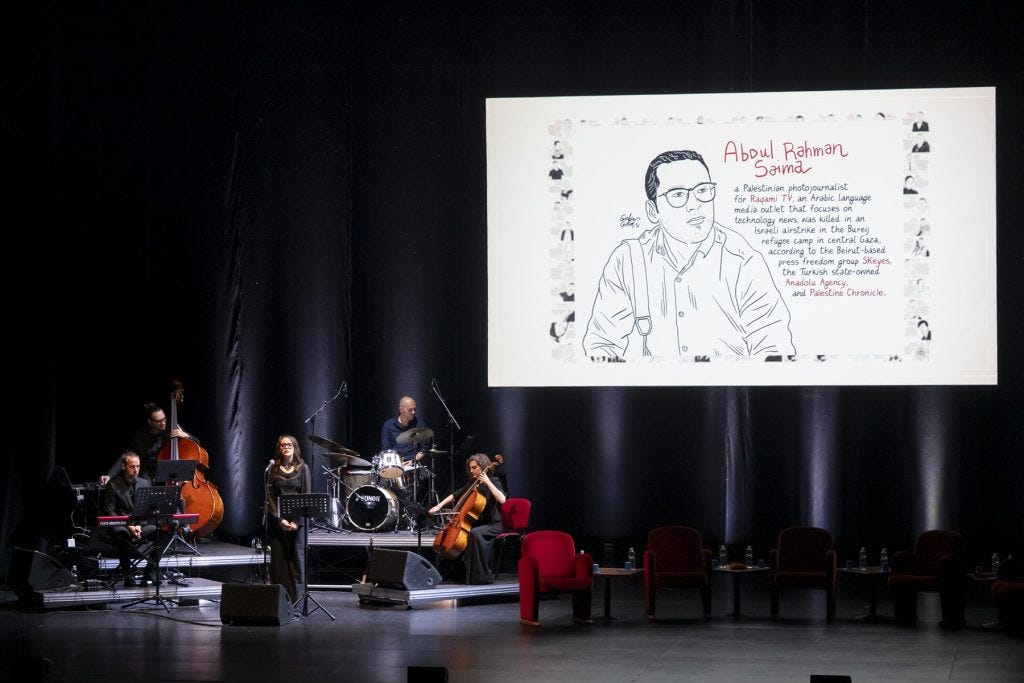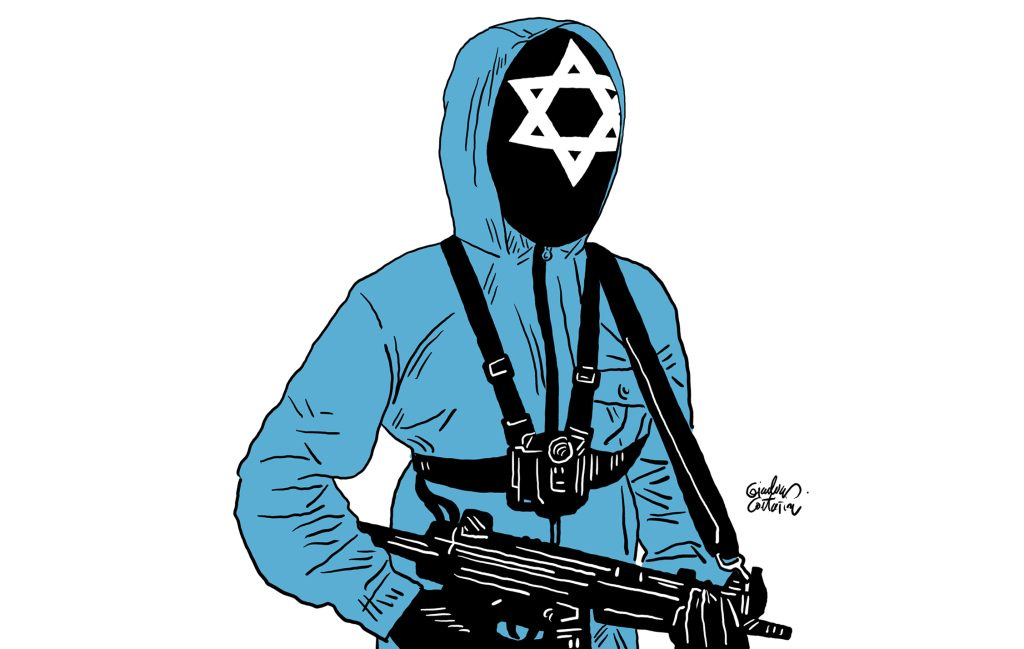Drawing Resistance: My Journey Documenting Palestine’s Crisis
Using art as a powerful tool for memory, solidarity, and human rights advocacy in the heart of conflict.
Over the past twenty-one months, I have dedicated a significant part of my artistic and civic work to the visual documentation of the crisis in Palestine, transforming drawing into a powerful tool of memory, protest, and solidarity. My illustrations are not mere portraits; they are activist testimonies that seek to restore dignity and humanity to those who are often reduced to statistics or erased by major international media.
One of the projects I feel most connected to is my contribution to Portraits of Journalists in the Israel-Gaza Conflict, an in-depth investigation exposing the systematic attacks on press freedom and the dangers journalists face in the Gaza Strip. In this context, I created portraits of Palestinian journalists who were killed or threatened while trying to report on the conflict, especially in cases where no photographs were available. With an essential but intense line, I aimed to give a human face to those brutally erased by violence, turning these images into a living memorial and an urgent call to defend freedom of information. This project began in collaboration with the Committee to Protect Journalists (CPJ) and evolved into a collective work meant to awaken the conscience of European policymakers and the public.
Throughout 2023 and 2024, my illustrations have been featured in numerous international events, amplifying messages of solidarity and resistance. At the NPF Journalism Awards Dinner in Washington D.C. in February 2024, my works were projected before hundreds of journalists, honoring the sacrifice of those who lost their lives reporting uncomfortable truths. The same spirit fueled vigils in memory of journalists killed during the Israel-Hamas war, such as those held in Seattle, Naples, and Atlanta in December 2023, where my drawings served as visual symbols to honor their dedication and courage.
Another important moment was the International Human Rights Festival (FIFDH) in Geneva in February 2025, where I presented the exhibition In the Crosshairs of Memory. The show focused attention on the assassination of journalists and humanitarian workers, particularly in Gaza, reinforcing the central role of drawing as a means of testimony and shared memory in the fight for press freedom and human rights.
Alongside the media crisis, I have also depicted the tragic humanitarian emergency hitting Gaza, especially the hunger caused by the Israeli blockade. My illustrations have supported the work of organizations like World Central Kitchen, committed to providing food to those starving in conflict zones. These drawings denounce not only famine but also the indifference and structural violence fueling the crisis. Through my graphic line, I try to make visible what often remains unseen, giving voice to the faces of suffering.



My work does not merely represent victims but intertwines with the stories of activists and peacebuilders fighting for a free and just Palestine. Among them is Issa Amro, a human rights defender from Hebron and founder of the Youth Against Settlements movement, who embodies nonviolent resistance. I chose to document and support his story of peaceful struggle, inspired by Gandhi, Martin Luther King, and Nelson Mandela, despite arrests, violence, and severe restrictions by the Israeli military occupation.
In 2024 and 2025, I closely followed solidarity demonstrations for Gaza on university campuses, particularly at Columbia University in New York. With my drawings, I sought to capture the energy and commitment of Palestinian and pro-Palestinian students, turning art into a tool of youth activism and political pressure within academic contexts. These events brought visibility to protests against the occupation and sparked international debate on the living conditions in the Gaza Strip.
This collaboration between art and activism is one of the most powerful features of my work. Drawing, for me, is never mere decoration or simple aesthetic representation: it is a political act, a form of resistance that builds collective memory and breaks the silence imposed by censorship and repression. Art thus becomes an integral part of the struggle for human rights, transforming every image into an act of testimony and solidarity.
In recent months, I have also documented the violence suffered by healthcare workers in the Gaza Strip. My project In the Line of Duty tells, through drawings, the tragic killing of eight medical personnel during bombings. These figures, often invisible to the media, are fundamental to the resilience of the Palestinian population and humanitarian support under siege. Through art, I aim to emphasize the importance of protecting those who risk their lives to care for others in extremely dangerous conditions.
The consistency and depth of my artistic commitment also manifest in local initiatives, such as the vigil organized by Palestinian media workers to commemorate journalist colleagues killed in the conflict. These moments, accompanied by my illustrations, express solidarity that transcends geographical boundaries and creates networks of support between those who report and those who fight for truth.
My intention is to create a living visual archive capable of accompanying and supporting the mobilizations of those fighting for justice and peace. I am not just an artist, but a witness who uses his pencil to illuminate dynamics often hidden in the Israeli-Palestinian conflict, restoring identity and voice to those too often silenced.
My work in Palestine is an example of how art can become a tool of civic engagement and political responsibility, capable of entering the heart of crises, amplifying stories of resistance, and reminding us that behind every name there is a face, a story, a life worth defending.
In May 2025, my commitment was again recognized at the Tiziano Terzani International Literary Prize during a special evening dedicated to the journalists of Gaza. The event honored the courage and dedication of those risking their lives for truth in one of the most difficult contexts worldwide, and my works played a central role in evoking the value of press freedom and collective memory.
Recently, I also reflected—through an artistic parallel with the series Squid Game—on how the dystopia portrayed in the fiction has become reality for millions of people in the Gaza Strip. This visual interpretation highlights how the extreme survival dynamics, exploitation, and systemic violence depicted in the series tragically mirror the daily conditions of Palestinians under siege, further expanding the critical and denunciatory power of my work.









